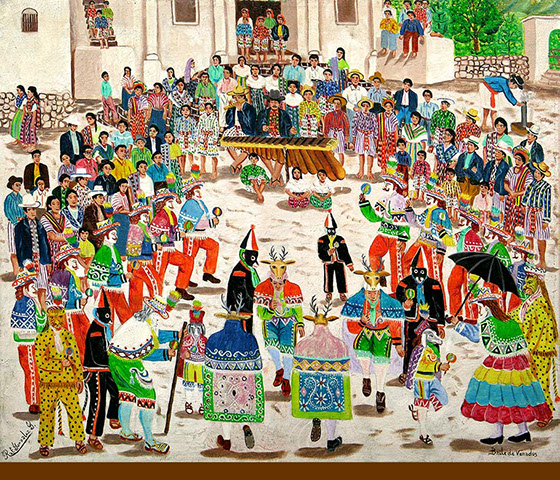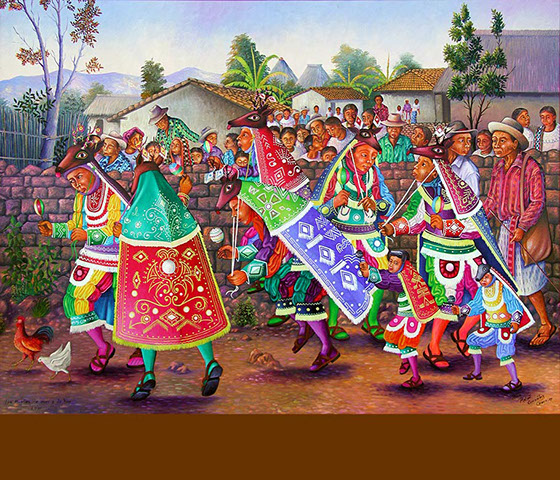About this painting by
Rafael González y González

Baile de Venado
[Deer Dance ]
Third Quarter, Twentieth century. 20” x 24”
Many of Rafael’s best paintings depict the traditions of his home town, San Pedro la Laguna. By the time he did the majority of his paintings, he had moved from San Pedro to the mixed Tz’utuhil/ladino town of Chicacao in the Piedmont area on the other side of the volcano. Still, when Rafael paints Maya traditions—such as the masked dances, marriage ceremonies, or processions—he most often places them in his home town of San Pedro where he knows from experience all the details. When he paints other Maya towns, more often than not it will be a market scene rather than the religious rituals. Rafael was quite well traveled, and it is clear that he draws the themes of his paintings from what he has observed.
In this painting, the Deer Dance is being performed in the plaza in front of the Catholic Church in San Pedro. The walled garden to the right of the church has long since disappeared. The plaza also has been leveled and a retaining wall constructed at the lower end. About half the distance of the plaza in front of the church has been paved, the other half contains a walkway down the center with a garden to either side. The gardens are inaccessible and uninviting because they are surrounded by chain-link fences. The masked dances are now performed in the street below, a much more restricted space. For people who know San Pedro, this painting depicts an earlier, more idyllic way of life, now gone.

A painting of the Deer Dance by Rafael’s grandson and namesake, Pedro Rafael, has a complete description of the dance. It might be useful to look at the two paintings together to observe how Tz’utuhil Maya painting has evolved. In his painting, Rafael makes the figures smaller in relation to the size of the canvas than his grandson, Pedro Rafael, does when depicting the same dance. Pedro Rafael is able to give minute detail to each dancer because the figures are larger, but Rafael is able to include the complete cast of dancers, while Pedro Rafael has pared down the number of dancers he can include. In Rafael’s painting we can also see how they perform a part of the dance in rows facing each other. Pedro Rafael’s painting is more saturated with color than his grandfather’s painting. Rafael uses more white or neutral colors for his backgrounds, with most of the color appearing in the people. White is almost absent in his grandson’s painting; it is used only as a color in the decoration of the costumes.
Some details to note: the old woman (played by a man or young boy) in the lower right hand corner, holds a black umbrella. Although I have asked many people why umbrellas are included in some of the paintings of dances, no one has been able to give me an answer—perhaps the dancers sometimes use them because they are an effective visual prop. Also, the man in the upper right-hand corner of the painting is setting off a pyrotechnic which will shoot several hundred feet in the air and make a loud bomb noise. It can easily be heard from across the lake. During festival days, men will get up well before dawn to set them off—of course waking everyone up.
Back to Rafael González y González paintings page.